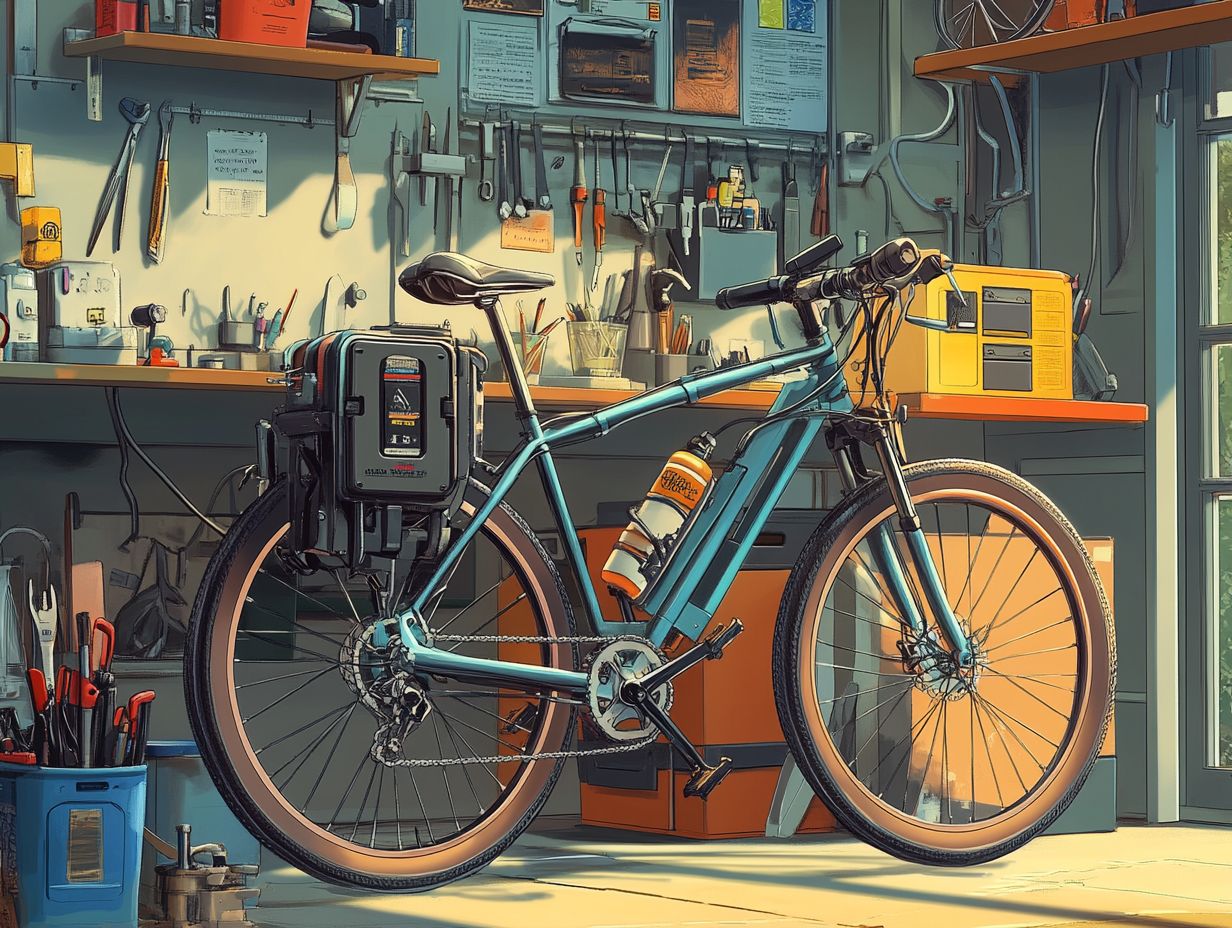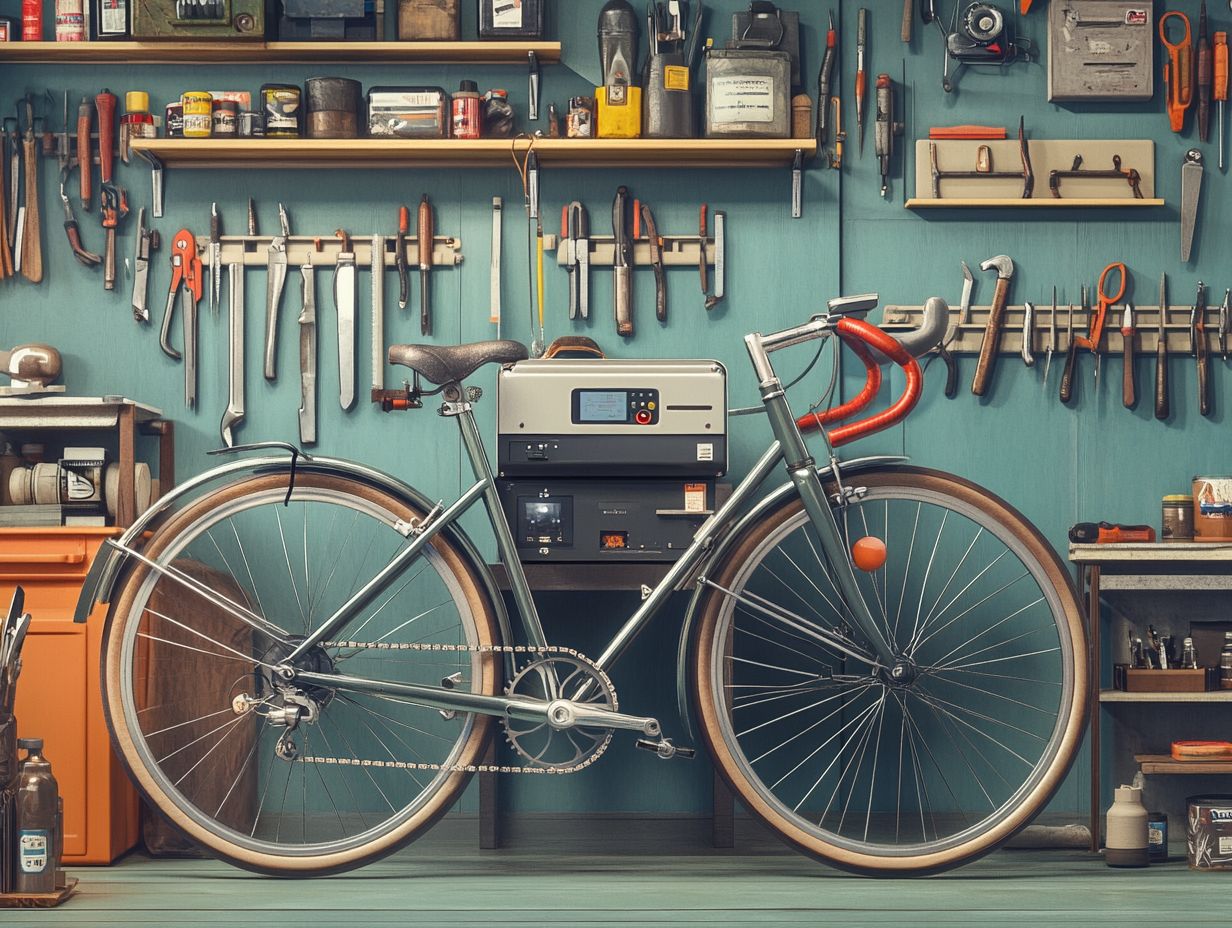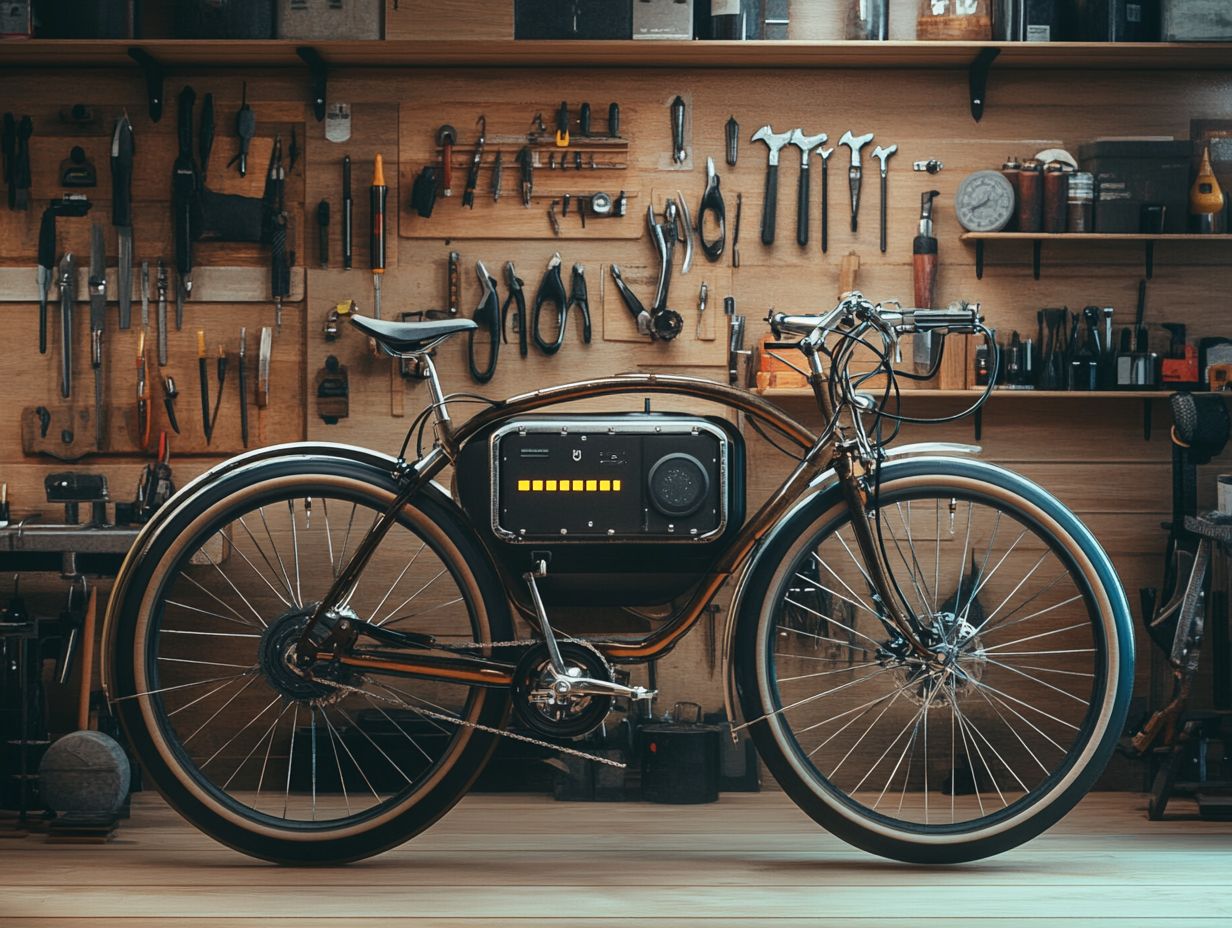How to Turn Your Bike into a Generator
Are you in search of a sustainable and innovative method to generate energy? Start your journey towards cleaner energy today! A bicycle generator could be exactly what you need.
This article delves into the concept of a bike generator, showcasing its myriad environmental and financial advantages. It offers a comprehensive, step-by-step guide on transforming your bike into a powerful generator, detailing the essential materials and tools required for the project, including a DC motor a device that turns mechanical energy into electrical energy and a lead-acid battery, a type of battery commonly used for storing electricity.
You will find tips to maximize your bike generator’s efficiency and ensure proper maintenance. Immerse yourself in this journey and discover how you can pedal your way to cleaner energy, harnessing pedal power to its fullest potential!
Contents
- Key Takeaways:
- Benefits of Using a Bike Generator
- How to Turn Your Bike into a Generator
- Materials and Tools Needed
- Tips for Efficient Use of Bike Generators
- Frequently Asked Questions
- What is a bike generator and why should I consider turning my bike into one?
- What materials do I need to turn my bike into a generator?
- Can any bike be turned into a generator?
- How much electricity can I generate with a bike generator?
- Do I need to modify my bike permanently to turn it into a generator?
- Are there any safety precautions I should take when using a bike generator?
Key Takeaways:

- Turn your bike into a bicycle generator to produce renewable energy and save money on your electricity bill.
- Building a DIY bike generator is easy and cost-effective with the right materials and tools.
- Maximize the power output and lifespan of your bike generator with efficient use and regular maintenance.
What is a Bicycle Generator?
A bike generator is your gateway to utilizing the strength of your own pedaling, transforming that mechanical energy into electrical energy truly a testament to human ingenuity. Picture this: a bicycle outfitted with a DC motor and a lead-acid battery, allowing you to produce a voltage output capable of charging everything from smartphones to USB devices and even small appliances.
This marvel gives you the power to maximize your pedal power while championing sustainability by utilizing clean energy sources.
The magic of a bike generator lies in how its main parts work together. As you pedal, the motion spins the wheels, which then drives the DC motor. Acting as a generator, this motor converts that rotational energy into electrical energy through the wonders of the process of converting motion into electricity and basic circuit design.
The electricity generated is stored in a lead-acid battery, providing you with a dependable power reserve for when you need it most. A power inverter then steps in, converting the stored direct current into alternating current, allowing for compatibility with a broader range of devices.
The practical applications of this technology are extensive. Take, for instance, advocates like Marie Verdeil, who champions its use in off-grid scenarios, or organizations such as the Infrastructure Academy that promote it in educational projects aimed at teaching sustainability principles.
These initiatives illustrate how your everyday biking can evolve into an impactful pursuit of green technology, adding a new layer of purpose to your rides.
Benefits of Using a Bike Generator
Utilizing a bike generator offers a wealth of benefits that go far beyond simple energy production, especially when considering the aspects of environmental technology and cost savings.
By transforming the kinetic energy generated from pedaling into electricity, you can greatly diminish your dependence on traditional fossil fuels, effectively addressing the energy losses typically encountered with conventional power generation. This sustainable method helps you cut down on utility bills while making a positive impact on the planet.
This approach not only aids in reducing your utility bills but also champions eco-friendly living by tapping into renewable energy sources.
Environmental and Financial Benefits
The environmental and financial benefits of bicycle generators are substantial. They position themselves as a great choice for people looking to go green. By utilizing a bicycle generator, a device that uses pedal power to create electricity, you can reduce your carbon footprint while simultaneously enjoying significant savings on your energy costs through the effective use of a lead-acid battery and efficient energy conversion. This approach contributes to environmental conservation efforts and eco-friendly living.
Statistics show that bike generators can cut greenhouse gas emissions by up to 1,200 pounds annually for each household that embraces this technology. This setup not only offers a renewable energy source but can also lead to decreased electricity bills, with some users reporting savings of 20% or more.
While the initial investment for a DIY bicycle generator may appear daunting typically ranging from $200 to $500 you may find that the long-term financial benefits, alongside the satisfaction of generating clean energy, make it a worthwhile venture. This is especially true when considering the reduction in electricity bills and the use of renewable energy sources.
Case studies have demonstrated that communities adopting these systems experience personal financial gains while also contributing positively to environmental conservation efforts. This showcases a remarkable synergy between personal cost savings and ecological responsibility. Some of these case studies are presented in forums like Low-tech Magazine and initiatives spearheaded by Infrastructure Academy.
How to Turn Your Bike into a Generator

Turning your bike into a generator is an exciting DIY adventure! This project beautifully merges creativity with engineering know-how, enabling you to harness your own power from pedal power.
To embark on this innovative journey, you ll need to outfit your bike with several key components, such as a dependable inverter and a thoughtfully designed circuit that efficiently converts mechanical energy into usable voltage. You may also consider using buck converters and boost converters, which are devices that help manage power levels, for better energy management.
This setup will allow you to charge your devices or power your appliances with the energy you generate on the go.
Step-by-Step Guide
This step-by-step guide will take you through the process of transforming your bicycle into a functional generator using DIY methods. We ll focus on essential elements like circuit design and the application of power inverters. By following these detailed instructions, you can harness your pedal power to generate electricity for a variety of applications, such as charging smartphones and powering small appliances.
Not only will you have the ability to power small electronics, but you ll also find immense satisfaction in contributing to sustainable energy practices.
The key components you ll need for this project include:
- A dynamo or alternator for initial energy conversion
- Buck converters
- Boost converters for increasing voltage output
- A battery for energy storage
- Necessary wiring and other electrical components
Safety first! Make sure to secure all wiring connections to prevent short circuits and utilize fuses to protect against overloads.
You ll also receive troubleshooting tips to help you diagnose common issues that may arise during construction, ensuring your project stays on track. Remember, optimal circuit configuration is essential for achieving the desired voltage output, so paying attention to detail throughout this process is crucial. Utilizing a multimeter can greatly assist in this troubleshooting process.
Don’t wait! Start this project now to enjoy the benefits of clean energy today!
Materials and Tools Needed
Ready to build an awesome bike generator? You will need a range of materials and tools, each serving a critical purpose in the project’s functionality and efficiency.
Key components include:
- A dependable DC motor for energy conversion
- A lead-acid battery for energy storage
- An inverter to ensure that the voltage output aligns with the needs of your electrical devices
- Buck converters and boost converters for managing power output
Essential Components for Building a Bike Generator
To build an effective bike generator, you’ll need to focus on essential components such as a DC motor for energy conversion, a lead-acid battery for energy storage, and a power inverter to transform the generated energy into usable voltage output. Understanding the significance of each component is vital for creating a circuit design that maximizes efficiency and minimizes energy losses.
By thoughtfully selecting each part, you can ensure that your bike generator operates at its best. The DC motor works like a dynamo, generating electricity as you pedal, while the lead-acid battery stores that energy for later use, providing you with reliable power even in low-light conditions. You can use a multimeter to regularly check the efficiency of these components.
The power inverter also converts stored DC power into AC current, making it usable for household appliances. Sourcing high-quality materials is imperative; as a DIY enthusiast, you should prioritize durability and energy-efficiency ratings when choosing components. Opting for eco-friendly materials not only promotes sustainability but also enhances the overall performance of your generator. Including electrical components such as buck and boost converters can further improve efficiency.
Tips for Efficient Use of Bike Generators

To ensure you make the most of your bike generator, consider implementing a few practical tips that can greatly enhance both energy output and longevity. This involves understanding the power needs of your devices and optimizing your generator to meet those needs efficiently.
By taking the time to maintain your bike generator properly and optimizing its compact design, you can significantly increase your ability to generate and store energy effectively. This makes it particularly beneficial for charging smartphones, USB devices, and powering small appliances with ease.
Maximizing Energy Output and Maintenance
Maximizing the energy output and maintenance of your bike generator requires a keen understanding of the relationship between your pedal power and how well energy is converted. Regular upkeep is essential to minimize energy losses. A well-maintained bike generator can efficiently power devices or charge batteries, thanks to its control panel that gives you the power to monitor performance metrics. Understanding the engineering experience involved can also help you make better adjustments over time.
To begin, optimizing your pedal speed and pedal power is essential; maintaining a consistent, steady pace boosts energy generation and lightens the load on your components. Ensuring a secure connection between your bike and the electrical components is vital to minimize disruptions in energy flow. Regularly lubricating moving parts and inspecting the generator for any signs of wear are straightforward maintenance practices that can extend the lifespan of your system. Incorporating a multimeter can also help monitor the system’s performance.
When setting up your control panel, include gauges for voltage and amperage to provide real-time feedback on energy usage and efficiency levels. It’s also useful to measure voltage output and power output for more detailed insights. By integrating these techniques, you can unlock the full potential of your bike generator while effectively managing your power needs.
Frequently Asked Questions
In this section, you’ll find answers to common questions about building and using bike generators. Don’t miss out on the chance to power your devices sustainably!
What is a bike generator and why should I consider turning my bike into one?
A bike generator is a device that uses the pedaling motion of a bicycle to generate electricity. This can be a great option for those looking for an eco-friendly and cost-effective way to power small appliances and devices.
It can also serve as a convenient backup plan for power outages or camping trips. This setup is part of advances in environmental technology.
What materials do I need to turn my bike into a generator?

You will need a bike, an alternator or generator, a battery (such as a lead-acid battery), a voltage regulator, and some wiring and connectors.
Depending on your level of expertise, you may also need some tools and guidance for the conversion process. If you’re new to this, follow a trial-and-error approach to find the best solutions.
Can any bike be turned into a generator?
Yes, any bike with a rear wheel and pedals can be turned into a generator. However, using a bike with a simple gear system, like a vintage exercise bike, is recommended. Multi-speed bikes can be more challenging to modify.
A DC motor, which converts direct current electricity into mechanical motion, is commonly used in these setups.
How much electricity can I generate with a bike generator?
In a study by Low-tech Magazine and Marie Verdeil, it was found that bike generators can effectively contribute to sustainable practices in urban settings. These generators were also featured at the Infrastructure Academy in 2016 and 2017.
The amount of electricity generated will depend on the power output of your alternator or generator, the speed and duration of pedaling, and the condition of your battery.
On average, a bike generator can produce around 100 watts of power, enough to charge a phone or power a laptop. For instance, you can use it for charging a smartphone or powering USB devices such as an electric kettle or a Peltier refrigerator.
Do I need to modify my bike permanently to turn it into a generator?
No, you do not need to make any permanent modifications to your bike. The components can be easily attached and removed, allowing you to switch between using your bike as a regular bicycle or as a generator.
This DIY bike project can be a fun and rewarding way to explore engineering skills.
Are there any safety precautions I should take when using a bike generator?
Make sure your circuit design is robust to prevent any mishaps. A power inverter helps change the electricity from your generator into a form that can power regular devices like corded power tools or PowerPoint presentations.
It s essential to ensure that the wiring and connections are secure and that the generator is properly grounded to prevent electrical shocks.
Using a voltage regulator is also recommended to prevent overcharging the battery. Don’t forget to use buck and boost converters to maximize your energy efficiency!
As with any physical activity, remember to stay hydrated and take breaks when needed.






